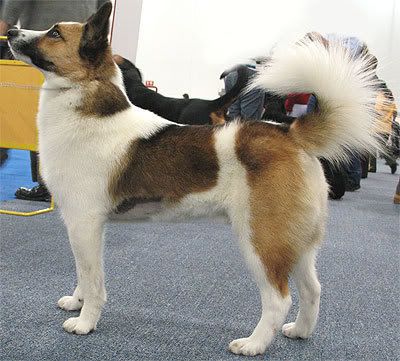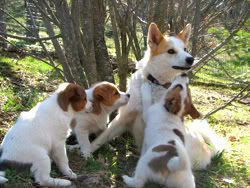Post by charmingnancy on Jan 13, 2009 13:23:07 GMT -5
Norbottenspets
Group: 2- Hounds
Origin: Sweden
Purpose: Hunting small game

Description:
The Norbottenspets, also known as the Nordic Spitz, is a breed of dog of the spitz type. It is an ancient breed whose original purpose was a farm and hunting dog but has recently became more popular as a companion dog.
Appearance- Breed Standards:
Small, squarish spitz dog, tightly built, with dry, powerful muscles. The dog should be of a very good structure, the head carried high and fearless. The dog should be extremely mobile. The ideal dog should give the impression of a typical, small spitz dog,
very alert and attentive, with good anatomy and mentality.
Coat and Color: Hard, short, straight and rather close fitting hair, fine and dense undercoat. Short on nosebridge, skull, ears and front of legs, longer on neck, back of thighs and underneath the tail. All colours permitted. Ideal colour is white with yellow or red/brown markings.
Head: The head should be powerful, dry, well built and viewed from front and side wedge formed. The muzzle moderately long, sharply tapering. The length, half length of head or shorter. The skull moderately wide, stop well but moderately marked, the forehead slightly arched and the skull moderately flat. The superciliary arches should be well marked and the nosebridge straight. The nose should be black and the lips thin, dry and tight fitting.
Mouth: Scissor bite with well developed teeth.
Eyes: The eyes moderately big, bright and expression calm and energetic. Dark brown. The eyes should be almond shaped and obliquely set.
Ears: High set, slightly over medium size and stiffly erect. Tips slightly rounded.
Neck: Moderately long, dry and muscular, with slightly arched neck, carried erect.
Body: Back short, strong, muscular and elastic. Viewed from side, slightly sloping over the withers and then straight. Loins short and broad. Croup moderately long and broad, slightly sloping and with well developed muscles. Chest moderately deep and long, the back ribs well developed. Oval shaped viewed from front. Forechest well developed and well marked. Front of normal width. Viewed from side, the lowest part of chestline should reach the underarm just below the elbow and softly fit into bellyline. Belly moderately tucked up. Depth of body (the vertical distance from highest point of withers to lowest point of chest) should be about half height of withers.
Fore and Hindquarters: Shoulder blade long and broad, with well developed chest and muscles. Close fitting to chest and proportionately set back. Upper Arm should be the same length as shoulder blade, strong, well fitting close to chest, but permit free movements and form a marked angle with the chest. Elbows directed backwards. Underarm straight, strong bones, dry but flexible muscles. Wrist and pastern strong. The underarm forming a straight line with wrist and pastern viewed from front. The pastern slightly angled forward viewed from side. Forefeet small, strong, standing straight forward, well arched and closed, with well developed, solid pads. Croup proportionately long, wide and strong, slightly sloping. Thighs proportionately long, forming a straight angle to pelvis. Strong muscles. Knee joint strong. Lower thigh forming a marked angle to upper thigh. Hock broad and strong, viewed from front and side. Rear pastern dry, elastic and rather long. Hind Feet as fore feet. Standing straight forward. Hindlegs parallel, viewed from behind.
Tail: Proportionately high set, carried in a fairly high curve, loosely curled with the tip of tail touching side of thigh. The length of tail should not reach below hock. Bobtail not allowed.
Gait: Norrbottenspets should, in canter and trot, show smooth, even movements with great drive, covering the ground well. Topline must be firm. Hindlegs must be parallel.
Faults: Any departure from the foregoing points should be considered a fault and the seriousness of the fault should be in exact proportion to its degree.
Size:
The height is 42 to 46cm (16.5 to 18in). The weight is approximately 11 to 15kg (24 to 33lb) for males, and 8 to 12kg (18 to 27lb) for females.

Temperament:
The Norrbottenspets is a loving dog that will display strong amounts of loyalty to their masters. Because they were bred to hunt, they will also have large amounts of bravery and independence. Overall, the Norrbottenspets makes an excellent companion. It is a great dog for families, and it may get along with other dogs due to its herding background. However, this breed should be socialized while they are puppies so that they can get along with both dogs and children.
Health:
The Norrbottenspets is a hardy dog that does not suffer from a large number of health problems. Any diseases it may develop are common with other dogs.
Average Lifespan:
The Norrbottenspets will have a maximum life expectancy of about 15 years.
History:
The breed originated in Sweden in the 1600's. They were first used as hunting companions in northern Sweden. They were first approved by the Swedish Kennel Club in 1910 then thought to be lost due to the two World Wars. In 1948, norbottenspets came close to extinction but enthusiasts sought out the few remaining and started a successful breeding program. They were found again during the late 1950's and now have made a come back with the FCI confirming the new breed standard in 1966 and the official name becoming Norrbottenspets. The standard was also accepted in Finland in 1973.
In Finland these dogs are called Pohjanpystykorva. Immigrant farmers have given the dog an even longer name, Norbottens-skollandehund. There is a great effort in Finland to ensure the health of these fox-like hunting dogs and breeding is highly controlled. Healthy animals, that are only distantly related, are being bred with careful consideration of breeding consultants to create a strong background. Sweden has also had a dramatic impact on the preservation of this breed through strict breeding practices.

Sources:
Canada's Guide to Dogs
CKC
Wikipedia
Dog Breed Site
AKC
Pictures:
Photobucket
Group: 2- Hounds
Origin: Sweden
Purpose: Hunting small game

Description:
The Norbottenspets, also known as the Nordic Spitz, is a breed of dog of the spitz type. It is an ancient breed whose original purpose was a farm and hunting dog but has recently became more popular as a companion dog.
Appearance- Breed Standards:
Small, squarish spitz dog, tightly built, with dry, powerful muscles. The dog should be of a very good structure, the head carried high and fearless. The dog should be extremely mobile. The ideal dog should give the impression of a typical, small spitz dog,
very alert and attentive, with good anatomy and mentality.
Coat and Color: Hard, short, straight and rather close fitting hair, fine and dense undercoat. Short on nosebridge, skull, ears and front of legs, longer on neck, back of thighs and underneath the tail. All colours permitted. Ideal colour is white with yellow or red/brown markings.
Head: The head should be powerful, dry, well built and viewed from front and side wedge formed. The muzzle moderately long, sharply tapering. The length, half length of head or shorter. The skull moderately wide, stop well but moderately marked, the forehead slightly arched and the skull moderately flat. The superciliary arches should be well marked and the nosebridge straight. The nose should be black and the lips thin, dry and tight fitting.
Mouth: Scissor bite with well developed teeth.
Eyes: The eyes moderately big, bright and expression calm and energetic. Dark brown. The eyes should be almond shaped and obliquely set.
Ears: High set, slightly over medium size and stiffly erect. Tips slightly rounded.
Neck: Moderately long, dry and muscular, with slightly arched neck, carried erect.
Body: Back short, strong, muscular and elastic. Viewed from side, slightly sloping over the withers and then straight. Loins short and broad. Croup moderately long and broad, slightly sloping and with well developed muscles. Chest moderately deep and long, the back ribs well developed. Oval shaped viewed from front. Forechest well developed and well marked. Front of normal width. Viewed from side, the lowest part of chestline should reach the underarm just below the elbow and softly fit into bellyline. Belly moderately tucked up. Depth of body (the vertical distance from highest point of withers to lowest point of chest) should be about half height of withers.
Fore and Hindquarters: Shoulder blade long and broad, with well developed chest and muscles. Close fitting to chest and proportionately set back. Upper Arm should be the same length as shoulder blade, strong, well fitting close to chest, but permit free movements and form a marked angle with the chest. Elbows directed backwards. Underarm straight, strong bones, dry but flexible muscles. Wrist and pastern strong. The underarm forming a straight line with wrist and pastern viewed from front. The pastern slightly angled forward viewed from side. Forefeet small, strong, standing straight forward, well arched and closed, with well developed, solid pads. Croup proportionately long, wide and strong, slightly sloping. Thighs proportionately long, forming a straight angle to pelvis. Strong muscles. Knee joint strong. Lower thigh forming a marked angle to upper thigh. Hock broad and strong, viewed from front and side. Rear pastern dry, elastic and rather long. Hind Feet as fore feet. Standing straight forward. Hindlegs parallel, viewed from behind.
Tail: Proportionately high set, carried in a fairly high curve, loosely curled with the tip of tail touching side of thigh. The length of tail should not reach below hock. Bobtail not allowed.
Gait: Norrbottenspets should, in canter and trot, show smooth, even movements with great drive, covering the ground well. Topline must be firm. Hindlegs must be parallel.
Faults: Any departure from the foregoing points should be considered a fault and the seriousness of the fault should be in exact proportion to its degree.
Size:
The height is 42 to 46cm (16.5 to 18in). The weight is approximately 11 to 15kg (24 to 33lb) for males, and 8 to 12kg (18 to 27lb) for females.

Temperament:
The Norrbottenspets is a loving dog that will display strong amounts of loyalty to their masters. Because they were bred to hunt, they will also have large amounts of bravery and independence. Overall, the Norrbottenspets makes an excellent companion. It is a great dog for families, and it may get along with other dogs due to its herding background. However, this breed should be socialized while they are puppies so that they can get along with both dogs and children.
Health:
The Norrbottenspets is a hardy dog that does not suffer from a large number of health problems. Any diseases it may develop are common with other dogs.
Average Lifespan:
The Norrbottenspets will have a maximum life expectancy of about 15 years.
History:
The breed originated in Sweden in the 1600's. They were first used as hunting companions in northern Sweden. They were first approved by the Swedish Kennel Club in 1910 then thought to be lost due to the two World Wars. In 1948, norbottenspets came close to extinction but enthusiasts sought out the few remaining and started a successful breeding program. They were found again during the late 1950's and now have made a come back with the FCI confirming the new breed standard in 1966 and the official name becoming Norrbottenspets. The standard was also accepted in Finland in 1973.
In Finland these dogs are called Pohjanpystykorva. Immigrant farmers have given the dog an even longer name, Norbottens-skollandehund. There is a great effort in Finland to ensure the health of these fox-like hunting dogs and breeding is highly controlled. Healthy animals, that are only distantly related, are being bred with careful consideration of breeding consultants to create a strong background. Sweden has also had a dramatic impact on the preservation of this breed through strict breeding practices.

Sources:
Canada's Guide to Dogs
CKC
Wikipedia
Dog Breed Site
AKC
Pictures:
Photobucket

